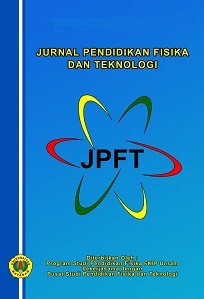Performance Analysis of Fifth-Semester Physics Education: Assessing an Online Pascal Compiler in the Department of Mathematics and Natural Sciences Education at University of Mataram
DOI:
10.29303/jpft.v10i1.7089Published:
2024-06-29Issue:
Vol. 10 No. 1 (2024): January-JuneKeywords:
Pascal Compiler, Undergraduate Physics Education, Programming Skills, Quantitative Analysis, Non-Parametric TestsArticles
Downloads
How to Cite
Downloads
Metrics
Abstract
This study evaluates the integration of online Pascal compilers in undergraduate physics education at the University of Mataram, focusing on its impact on students' programming skills. Over one semester, three classes (A, B, and C) of physics education students from the Department of Mathematics and Natural Sciences Education (PMIPA), Faculty of Teacher Training and Education (FKIP), University of Mataram, participated in lectures, discussions, and practical exercises using the GDB Online Pascal Compiler. Course content included Pascal fundamentals, arrays, matrices, and applications in physics, evaluated through assignments, mid-semester, and final exams. Quantitative analysis of student performance data revealed significant differences in mean scores and variability among the classes, with Class A achieving the highest average score and Class C exhibiting the greatest variability. Statistical tests confirmed that performance data for all classes deviated significantly from normal distribution, necessitating non-parametric tests. The Mann-Whitney U test indicated no statistically significant differences in median scores between class A vs. class B, class A vs. class C, and class B vs. class C, suggesting consistent performance outcomes across classes post-course. These findings underscore the potential of the online Pascal compiler in enhancing students' programming skills within the context of physics education.
References
Derrac, J., García, S., Molina, D., & Herrera, F. (2011). A practical tutorial on the use of nonparametric statistical tests as a methodology for comparing evolutionary and swarm intelligence algorithms. Swarm and Evolutionary Computation, 1(1), 3-18. https://doi.org/10.1016/j.swevo.2011.02.002 DOI: https://doi.org/10.1016/j.swevo.2011.02.002
Gomes, A., & Mendes, A. J. (2007). Learning to program - difficulties and solutions. In International Conference on Engineering Education (ICEE-2007), Coimbra, Portugal.
Harimurti, Rina, Ekohariadi, Munoto, Asto B I Gusti Putu, Winanti,Elizabeth Titiek 2019. Analysis Of Programming Skills Concept In Developing Problem Solving Skills. Jurnal Pendidikan Teknologi dan Kejuruan, Vol. 25, No. 1, May 2019, 43-51. DOI: 10.21831/jptk.v25i1.22638 DOI: https://doi.org/10.21831/jptk.v25i1.22638
Khairiah, Irmayati.,2023. Algoritma Pemrograman : Studi Pustaka Pemahaman Algoritma Pemrograman. Konstanta : Jurnal Matematika dan Ilmu Pengetahuan Alam,Vol. 1, No. 4 Desember 2023, DOI : https://doi.org/10.59581/konstanta.v1i4.1673
Krishnamurthi, S., & Fisler, K. (2019). Programming paradigms and beyond. In The Cambridge Handbook of Computing Education Research (pp. 182-226). Cambridge University Press. https://doi.org/10.1017/9781108654555.006 DOI: https://doi.org/10.1017/9781108654555.014
Lahtinen, E., Ala-Mutka, K., & Järvinen, H. M. (2005). A study of the difficulties of novice programmers. ACM SIGCSE Bulletin, 37(3), 14-18. https://doi.org/10.1145/1151954.1067453 DOI: https://doi.org/10.1145/1151954.1067453
Munandar, H., Sutrio, S., & Taufik, M. (2018). Pengaruh Model Pembelajaran Berbasis Masalah Berbantuan Media Animasi Terhadap Kemampuan Berpikir Kritis dan Hasil Belajar Fisika Siswa SMAN 5 Mataram Tahun Ajaran 2016/2017. Jurnal Pendidikan Fisika Dan Teknologi, 4(1), 111–120. https://doi.org/10.29303/jpft.v4i1.526 DOI: https://doi.org/10.29303/jpft.v4i1.526
Peng, C. Y. J., Harwell, M., Liou, S. M., & Ehman, L. H. (2019). Advances in missing data methods and implications for educational research. In M.J.R. David (Ed.), Quantitative Methods and Data Analysis in Education Research (pp. 1-31). University of Kansas. https://doi.org/10.7936/AHVJ-1883
Robins, A., Rountree, J., & Rountree, N. (2003). Learning and teaching programming: A review and discussion. Computer Science Education, 13(2), 137-172. DOI: https://doi.org/10.1076/csed.13.2.137.14200
Sherin, B. L. (2001). How students understand physics equations. Cognition and Instruction, 19(4), 479–541. https://doi.org/10.1207/S1532690XCI1904_3 DOI: https://doi.org/10.1207/S1532690XCI1904_3
Zuhdi, M., Taufik, M., Sutrio, S., & Ayub, S. (2019). Pemodelan Sesar Pasca Gempa Dengan Inversi Data Gravitasi Time Lapse. Jurnal Pendidikan Fisika Dan Teknologi, 5(1), 156–161. https://doi.org/10.29303/jpft.v5i1.1109 DOI: https://doi.org/10.29303/jpft.v5i1.1109
Author Biographies
Muhammad Taufik, University of Mataram
Physics Education Study Program
Syahrial Ayub, University of Mataram
Physics Education Study Program
License
Copyright (c) 2024 Muhammad Taufik, Syahrial Ayub

This work is licensed under a Creative Commons Attribution-ShareAlike 4.0 International License.
Authors who publish with Jurnal Pendidikan Fisika dan Teknologi (JPFT) agree to the following terms:
- Authors retain copyright and grant the journal right of first publication with the work simultaneously licensed under a Creative Commons Attribution License 4.0 International License (CC-BY-SA License). This license allows authors to use all articles, data sets, graphics, and appendices in data mining applications, search engines, web sites, blogs, and other platforms by providing an appropriate reference. The journal allows the author(s) to hold the copyright without restrictions and will retain publishing rights without restrictions.
- Authors are able to enter into separate, additional contractual arrangements for the non-exclusive distribution of the journal's published version of the work (e.g., post it to an institutional repository or publish it in a book), with an acknowledgement of its initial publication in Jurnal Pendidikan Fisika dan Teknologi (JPFT).
- Authors are permitted and encouraged to post their work online (e.g., in institutional repositories or on their website) prior to and during the submission process, as it can lead to productive exchanges, as well as earlier and greater citation of published work (See The Effect of Open Access).











